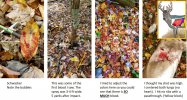35-acre
5 year old buck +
I shot a doe last weekend. She was broadside and not on alert at all. My initial thought was it was a great shot but then the doubts crept in and I started thinking that I might have hit her a little high. Those doubts grew as I was climbing down my tree that I wasn't going to get her. Once on the ground, I started looking at the spot where I thought she was standing and couldn't find my arrow or any blood - more doubts. As I walked a little further away from my stand tree toward where she could have been standing, I noticed the tree in the second pic here. I back-tracked a bit, found the arrow and more initial sign. Things were looking up in a BIG way.
The blood trail was what most people would describe as a walking blood trail. I couldn't even capture pictures that were good enough to represent just HOW MUCH BLOOD there was! The whole trail was 3-4 feet wide of spray. I'm not sure if you can zoom in on the blood pic (3rd) and see it all. It was a crazy amount of blood!
The doe went about 50 yards. She ran in a small arc. She was dead in seconds (If I had to guess it was bout 5 seconds). I didn't take a pic of the lungs. I did check the heart all over and didn't nic it at all. The entry and exit wounds are parallel on the body. She was slightly above me at 20 yards. I marked a yellow block where the lungs were impacted on the drawing that I embedded in the "body pic". I will say and you can see this on the body pic, the 2 blade opened vertically. After field dressing I noticed that the blades never contacted ribs/bone while passing entirely through the body and wedging into a rotted log.
I wanted to put this up so people see some positives and gain some experience from mine.
I was trying to film this shot (and failed) because of that, I didn't mark a spot where she was standing when I shot her.
I didn't hear her crash. She came to rest in the crotch of a tree and on a log so there was no sound to be heard.
After seeing the amount of blood, based on experience, I took the trail up within 15-20 minutes.
Once I started following her path, I looked up and saw the body about 40 yards away.
In total she ran about 50 yards and like I noted above was probably dead in 5 or so seconds.
This was all about blood-loss/hemorrhage. I have heard a deer need to lose about the same amount of blood that would be found in 4 water bottles. So when tracking, you need to determine/understand how much you'r seeing and pace yourself from that.
I hope there is something people can learn through all of our experiences.

The blood trail was what most people would describe as a walking blood trail. I couldn't even capture pictures that were good enough to represent just HOW MUCH BLOOD there was! The whole trail was 3-4 feet wide of spray. I'm not sure if you can zoom in on the blood pic (3rd) and see it all. It was a crazy amount of blood!
The doe went about 50 yards. She ran in a small arc. She was dead in seconds (If I had to guess it was bout 5 seconds). I didn't take a pic of the lungs. I did check the heart all over and didn't nic it at all. The entry and exit wounds are parallel on the body. She was slightly above me at 20 yards. I marked a yellow block where the lungs were impacted on the drawing that I embedded in the "body pic". I will say and you can see this on the body pic, the 2 blade opened vertically. After field dressing I noticed that the blades never contacted ribs/bone while passing entirely through the body and wedging into a rotted log.
I wanted to put this up so people see some positives and gain some experience from mine.
I was trying to film this shot (and failed) because of that, I didn't mark a spot where she was standing when I shot her.
I didn't hear her crash. She came to rest in the crotch of a tree and on a log so there was no sound to be heard.
After seeing the amount of blood, based on experience, I took the trail up within 15-20 minutes.
Once I started following her path, I looked up and saw the body about 40 yards away.
In total she ran about 50 yards and like I noted above was probably dead in 5 or so seconds.
This was all about blood-loss/hemorrhage. I have heard a deer need to lose about the same amount of blood that would be found in 4 water bottles. So when tracking, you need to determine/understand how much you'r seeing and pace yourself from that.
I hope there is something people can learn through all of our experiences.

